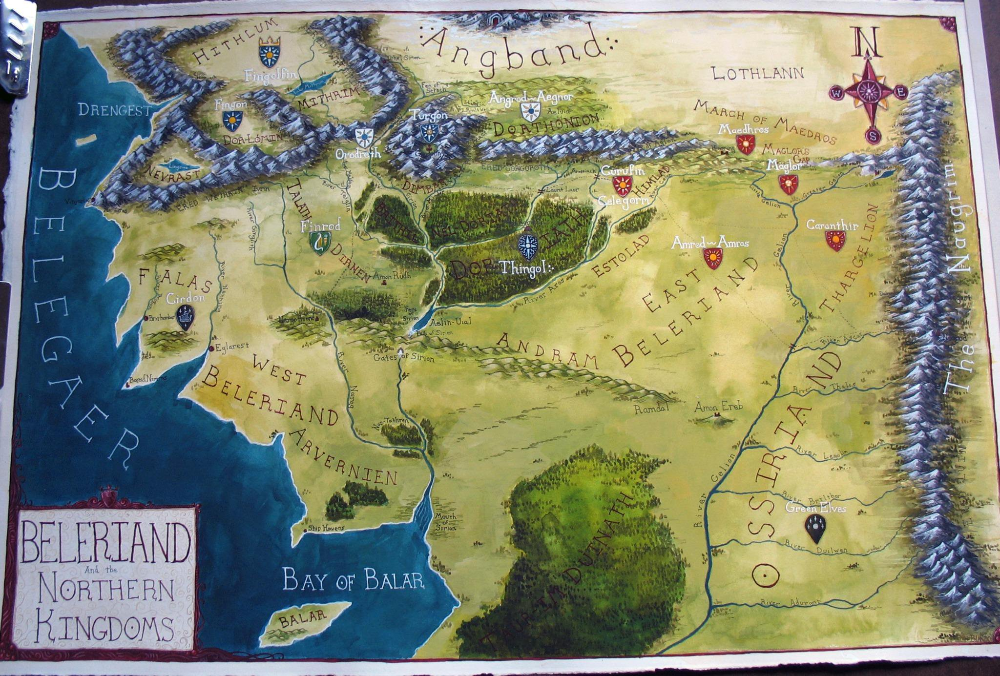Blind Read Through: J.R.R. Tolkien; The Silmarillion, Of Beleriand and its Realms, pt. 1

“Thus the realm of Finrod was the greatest by far, though he was the youngest of the great lords of the Noldor, Fingolfin, Fingon, and Maedhros, and Finrod Felagund. But Fingolfin was held overlord of all the Noldor, and Fingon after him, though their own realm was but the northern land of Hithlum; yet their people were the most hardy and valiant, most feared be the Orcs and most hated by Morgoth.”
Welcome back to another Blind Read! This week we delve into the realm of Beleriand and gain a greater understanding of where each faction of the Eldar takes as their home.
The book has gone beyond being very dry to transitioning to some fascinating tales. So, unfortunately, this chapter takes a step backward, but for an important reason:
“This is the fashion of the lands into which the Noldor came, in the north of the western regions of Middle-earth, in the ancient days; and here also is told of the manner in which the chieftains of the Eldar held their lands and the leaguer upon Morgoth after the Dagor Aglared, the third battle in the Wars of Beleriand.”
We finally get some reference to the locations and people described.
Tolkien was known to love nature and hate what industry did to the purity of the world. We can see this in The Lord of the Rings movies on full display with the destruction of Fangorn Forest through the industry of Isengard. Here, in the First Age, Morgoth does much the same. First, he makes his fortress in the wastes of the north and calls it Angband, otherwise known as “The Hells of Iron.” He then built a great tunnel leading out of Ered Elgin (Ered is the Elvish name for Mountain. Thus, Ered Elgin is called the Iron Mountains) for his minions to spread throughout Beleriand. At the end of this tunnel, he built a mighty gate, “But above this gate, and behind it even to the mountains, he piled the thunderous towers of Thangorodrim, that were made of the ash and slag of his subterranean furnaces, and the vast refuse of his tunnelings.”
This passage shows the Evil (with a capital E) in Tolkien’s eyes. The destruction of the world in the (false) name of progress.
But since this chapter glosses over events, for want of explaining locals, we switch to the other residents of Beleriand who managed to live with and in the world, just as Yavanna’s song of creation would have them.
“To the West of Thangorodrim lay Hísilómë, the Land of Mist…Hithlum it became in the tongue of the Sindar who dwelt in those regions.“
From my meager knowledge, I believe that the lands of Beleriand make up much of what we know of the landscape of Middle-earth in the Third Age, and based upon the name of the region, could this be what will become the Misty Mountains? There is no direct correlation except through the wording. However, Tolkien was always so specific with his world and language that I will go out on a limb and say it’s so.
Then we come across another little gem hidden in the text. Within Hithlum to the south is a region known as Dor-Lómin:
“But their cheif fortress was at Eithel Sirion in the east of Ered Wethrin, whence they kept watch upon Ard-galen; and their cavalry rode upon that plain even to the shadow of Thangorodrim, for from few their horses had increased swiftly…Of those horses many of the sires came from Valinor,”
I have to wonder if these are the glorious beginnings of the wonderous horses of the Rohirrim, which we see in “The Two Towers” as the riders of Rohan, whose duty it was to guard the fields of that land. Again there is no definitive statement, but it makes quite a bit of sense.
Moving west still, we go to Nevrast, where “for many years was the realm of Turgon the wise, son of Fingolfin.” Nevrast was a marshy land settled between the sea and the mountains where most of the Grey-elves lived.
Directly east of Dor-Lómin, across Ered Wethrin and Tol (Elvish for River) Sirion, lay Dorthonion where “Angrond and Agnor, sons of Finarfin, looked out over the fields of Ard-galen.” and in the west of Dorthonion was the Tol Sirion, where Finrod ruled. It was there, “in the midst of the river he built a mighty watch-tower, Minas Tirith; but after Nargothrond was made he committed that fortress mostly to the keeping of Orodreth, his brother.“
Minas Tirith! I had no idea Minas Tirith was built in the first age! No wonder it is so massive and beautiful! It was created in the “Pass of Sirion,” the largest and most prominent passage to Beleriand from Ard-galen and where Morgoth would most likely take a straight shot to attack that land. Minas Tirith, and Gondolin, which were built on the opposite side of the river, are the two most significant guardians of the land created by the Eldar.
The last region we’ll talk about this week is the March of Maedhros, which was east of Dorthonian. It was here “dwelt the sons of Fëanor with many people, and their riders often passed over the vast northern plain, Lothlann the wide and empty, east of Ard-galen, lest Morgoth should attempt any sortie against East Beleriand.”
This region was known as Himring, the Ever-cold, “and that was wide-shouldered, bare of trees, and flat upon its summit, surrounded by many lesser hills.” I thought about this area quite a bit, and I wonder if this might be Weathertop, where Frodo took the poison of the blade of the nine. The description of the geography seems appropriate, but I’m unsure of the region.
What is so fascinating is that the Gray Elves, or Sindar, had never gone to Valinor. Instead, Thingol married a Maiar named Melian, and they took up residence in Beleriand (look back at the Girdle of Melian here). Still, it was Fëanor and Fingolfin who came after during the departure of the Noldor from Valinor. These two relations took a protective stance against the rest of the realm.
All locations described in this part of the chapter are lookouts or guards surrounding Ard-Galen so that they might protect against Morgoth and his minions. The opening quote of this essay describes their purpose nicely because it’s curious that Thingol, the Elf who had been there the longest, with a Wife who is more powerful than any Eldar, would hide within their girdle. At the same time, the Noldor would be the protectors. But it is because of that hatred Fëanor had for Morgoth that this came to being.
When he died, his sons took up his mantle, and where they didn’t have the fire, he had to go after Morgoth actively; they took it as their duty to guard the land and stop The fallen Valar from further destruction.
Join me next week as we cover the remainder of Beleriand and complete this chapter!








Leave a comment